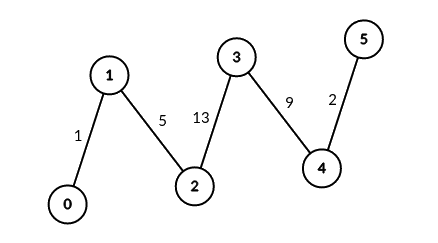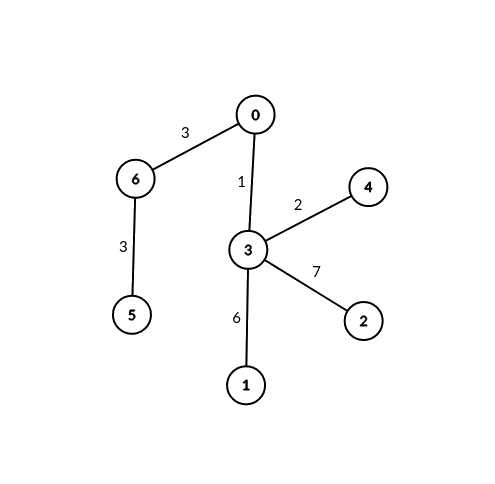package
0.0.0-20241113083646-cc50aed9d7d0
Repository: https://github.com/godcong/leetcode.git
Documentation: pkg.go.dev
# README
在带权树网络中统计可连接服务器对数目
给你一棵无根带权树,树中总共有 n 个节点,分别表示 n 个服务器,服务器从 0 到 n - 1 编号。同时给你一个数组 edges ,其中 edges[i] = [ai, bi, weighti] 表示节点 ai 和 bi 之间有一条双向边,边的权值为 weighti 。再给你一个整数 signalSpeed 。
如果两台服务器 a 和 b 是通过服务器 c可连接的,则:
a < b,a != c且b != c。- 从
c到a的距离是可以被signalSpeed整除的。 - 从
c到b的距离是可以被signalSpeed整除的。 - 从
c到b的路径与从c到a的路径没有任何公共边。 请你返回一个长度为n的整数数组count,其中count[i]表示通过服务器i可连接 的服务器对的 数目 。
示例 1:

输入:edges = [[0,1,1],[1,2,5],[2,3,13],[3,4,9],[4,5,2]], signalSpeed = 1
输出:[0,4,6,6,4,0]
解释:由于 signalSpeed 等于 1 ,count[c] 等于所有从 c 开始且没有公共边的路径对数目。
在输入图中,count[c] 等于服务器 c 左边服务器数目乘以右边服务器数目。
示例 2:

输入:edges = [[0,6,3],[6,5,3],[0,3,1],[3,2,7],[3,1,6],[3,4,2]], signalSpeed = 3
输出:[2,0,0,0,0,0,2]
解释:通过服务器 0 ,有 2 个可连接服务器对(4, 5) 和 (4, 6) 。
通过服务器 6 ,有 2 个可连接服务器对 (4, 5) 和 (0, 5) 。
所有服务器对都必须通过服务器 0 或 6 才可连接,所以其他服务器对应的可连接服务器对数目都为 0 。
提示:
-
2 <= n <= 1000 -
edges.length == n - 1 -
edges[i].length == 3 -
0 <= ai, bi < n -
edges[i] = [ai, bi, weighti] -
1 <= weighti <= 106 -
1 <= signalSpeed <= 106 -
输入保证
edges构成一棵合法的树。